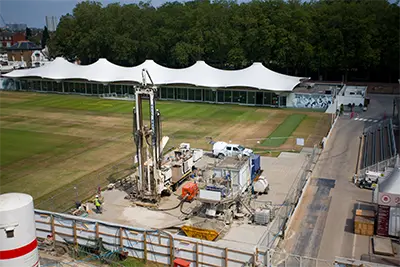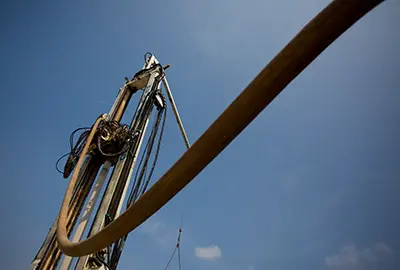

Geothermal
As energy efficiency and decarbonisation climb higher on the agenda for developers, landowners, commercial operators and local authorities, interest in geothermal systems continues to grow.
About
Geothermal Borehole Drilling
With the ability to harness clean, renewable energy directly from the ground, geothermal drilling is the foundation of ground source heating and cooling systems - and Igne is one of the UK’s most experienced contractors in this field.
Whether you're designing a district heating network, powering a commercial building, or exploring mine water as an energy source, we provide the technical drilling expertise that makes it possible.
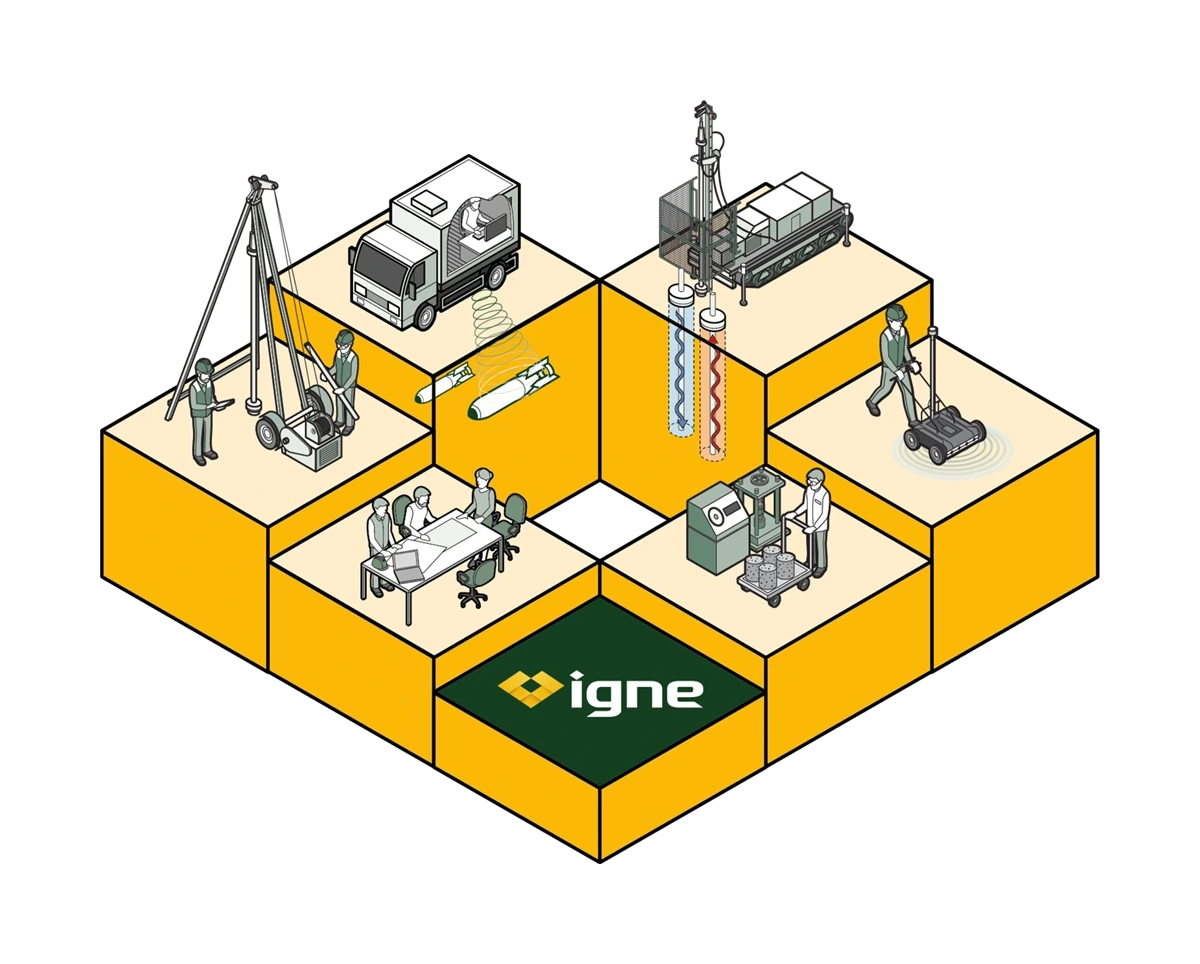
The explanation
What Is Geothermal Energy?
Geothermal energy is the natural heat stored beneath the Earth's surface. It comes from solar energy absorbed by the ground and from the residual heat of the Earth’s core. Unlike fossil fuels, geothermal is constantly replenished and doesn't rely on combustion.
It’s a renewable, low-carbon source of energy that can be tapped into using boreholes and ground source heat pumps to provide consistent heating and cooling year-round.
Geothermal extraction
How Boreholes Access Heat Underground
To extract geothermal energy, specialist boreholes are drilled into the ground, typically to depths of 100 to 250 metres, and in some cases deeper. These boreholes serve as vertical conduits for heat transfer between the ground and the building or system above.
In open loop systems, groundwater is drawn from the ground, passed through a heat exchanger, and then reinjected. In closed loop systems, a fluid circulates through a sealed pipe network to absorb heat from the surrounding geology.
At Igne, we specialise in open loop geothermal borehole drilling, delivering the high-precision, high-integrity installations required for long-term, efficient operation.
Reversible Process
Heating & Cooling from the Same Source
One of the major advantages of geothermal systems is their ability to both heat and cool buildings. In winter, heat is extracted from the ground and transferred into the building. In summer, the system works in reverse, moving excess heat from the building back into the cooler ground.
This reversible process provides highly efficient thermal comfort all year round, while cutting operational emissions and energy bills.
The uses
Where Geothermal Really Comes into Its Own
Geothermal systems are especially well-suited to:
- Data centres requiring efficient, stable cooling
- Energy-intensive manufacturing facilities
- Schools, universities and hospitals
- Residential developments with net-zero targets
- Public buildings and leisure facilities
- Rural estates seeking off-grid solutions
- District heating schemes and local energy networks
They are also increasingly used in retrofit and regeneration projects where ground access is possible.
weightng the options
Open Loop vs Closed Loop Systems
While both systems use boreholes, open loop geothermal systems offer higher efficiency and flexibility, particularly in water-rich geology. These systems abstract water from an aquifer with one borehole, pass it through a heat exchanger, and reinject it into the aquifer via a second borehole.
This water circuit ensures minimal environmental disruption and excellent performance.
By contrast, closed loop systems circulate glycol or similar fluids in a sealed loop. While simpler in concept, they generally require more boreholes or a horizontal trench system, which can take up significant space.
Open loop systems have key advantages:
- Use fewer, deeper boreholes; ideal for space-restricted sites
- Provide higher thermal yields from groundwater
- Support greater seasonal temperature consistency
- Are more scalable for larger systems
Igne is a recognised expert in open loop borehole design and installation, with a strong track record in both rural and urban environments.
Clean energy
Sustainable, Renewable, Low-Impact Energy
Geothermal energy is among the cleanest energy solutions available today. It produces no on-site emissions, requires no fuel deliveries, and has minimal visual or noise impact once installed. Because water is returned to the same aquifer it came from, the environmental footprint is incredibly low.
With correct design, permitting and monitoring, all services Igne can support, geothermal boreholes provide decades of reliable, renewable energy with almost no ongoing disruption.
The advantages
Challenges & Considerations
Like all ground-based technologies, geothermal systems require careful planning and professional delivery.
Challenges can include:
- Planning permission and abstraction licensing
- Understanding local geology and aquifer behaviour
- Access on tight or built-up sites
- Managing multiple boreholes in phased developments
But the advantages far outweigh the challenges:
- Lower energy costs and carbon emissions
- Year-round performance
- Long system lifespan (over 50 years for boreholes)
- Low maintenance and quiet operation
- Strong return on investment over time
Heat Pumps
The Role of Ground Source Heat Pumps
The connection between the borehole and the building is made via a ground source heat pump (GSHP). This device extracts the heat from the groundwater or circulating fluid and upgrades it for use in radiators, underfloor heating or hot water systems.
Igne works closely with system designers, mechanical and electrical consultants and heat pump specialists to ensure the drilled infrastructure matches system performance needs precisely.
Mine water geothermal
Mine Water & District Heating Expertise
Igne is also at the forefront of mine water geothermal, using the stored heat in flooded abandoned mines to supply low-carbon energy to entire communities. With specialist knowledge of mine workings, hydrogeology and deep borehole design, we help clients unlock the clean energy stored in dirty legacy infrastructure.
We also support district heating schemes, drilling the production and reinjection boreholes that serve entire residential or commercial zones. Our experience in both public and private sector projects makes us a trusted partner in delivering large-scale, low-carbon infrastructure.
Learn about our Geothermal Services in more detail:

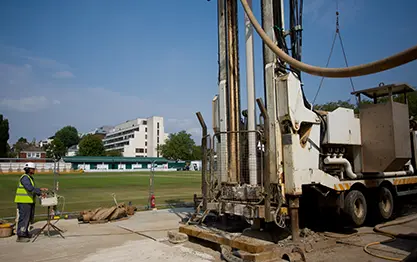
Open Loop Geothermal Drilling
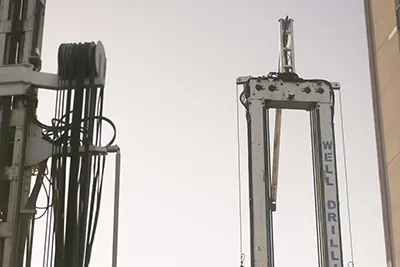
Closed Loop Geothermal Drilling
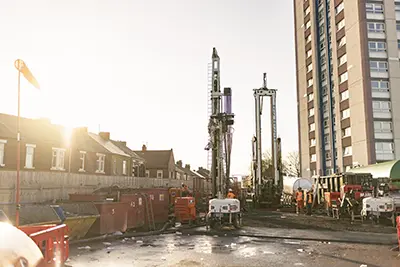
Minewater Geothermal Boreholes
FAQ
Frequently Asked Questions about Geothermal Borehole Drilling
- How deep are geothermal boreholes?
Most are between 100 and 250 metres, though they can be deeper depending on the required capacity and geological conditions.
- Do geothermal systems work in all parts of the UK?
Yes, with the right design. While local geology affects the yield, geothermal systems can be tailored to work almost anywhere in the UK.
- Is planning permission required?
Sometimes. For open loop systems, you may also need abstraction and reinjection licences from the Environment Agency. Igne can assist with this process.
- Is open loop better than closed loop?
Open loop systems generally offer higher efficiency and need fewer boreholes, but they require suitable groundwater availability. Igne can assess which approach is best for your site.
- Can I retrofit a geothermal system to an existing building?
Yes, provided there is enough ground space and access. Vertical boreholes make this possible even on tight or urban sites.
The Next Step
Igne: The Geothermal Experts
Whether you're designing a low-carbon home or a high-capacity heat network, geothermal starts with the borehole, and that’s where Igne comes in.
We’ve drilled thousands of metres of geothermal infrastructure, from domestic loops to deep mine systems, delivering precision, compliance and long-term value for our clients.
Contact us today to find out how our geothermal borehole expertise can support your project.

Water Wells

Advanced Drilling & Installations
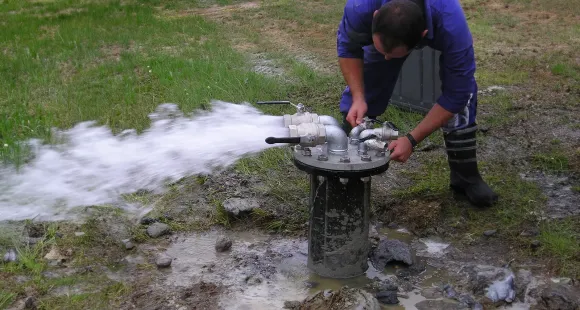
Maintenance Contracts

Well Cleaning & Rehabilitation
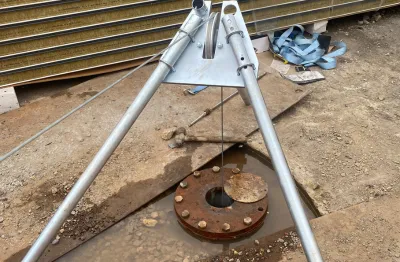
Borehole Geophysics & CCTV

Wireline Geophysics
